The Lithographs of Andreana Dobreva
“Every stone is an individual and you have to listen to it." This understanding helped me to move from canvas to stone.
Interview with artist Andreana Dobreva and printer Deborah Chaney-Guilbaud (Deb Chaney Editions, Ateliers Stéphane Guilbaud), conducted by Silvia Positano (Emanuel von Baeyer London).
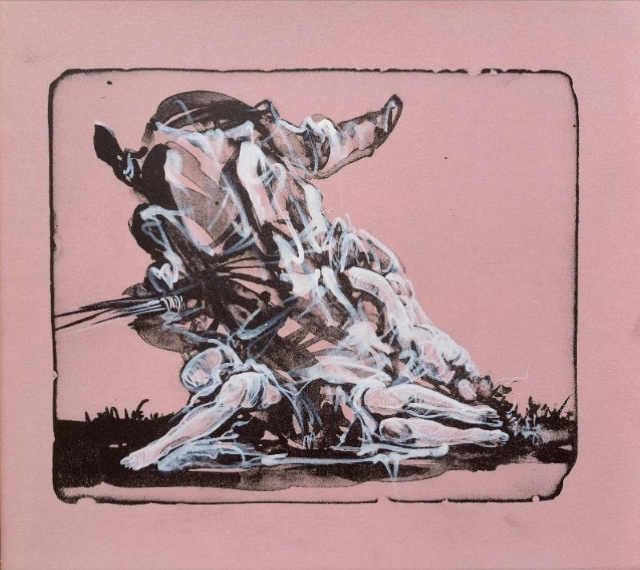
SP: Deborah, you are a trained Tamarind Master Printer, and your own studio is specialised in lithography. How did you focus on this specific printmaking technique?
DCG: I first discovered lithography and fell in love with it when I was in college, studying at the University of Tennessee. They had a wonderful printmaking programme there and I had a friend taking a litho class who took us on a tour of the print studio and showed us how he was drawing on rocks. Then I heard about the Tamarind Institute of Lithography in New Mexico and learnt that there was this way of doing printmaking collaboratively where you can work with artists and still be creative, whilst focusing on the technical side of the process. There is a real art in collaborative printmaking where you have to access the mind of the artist, studying their work and trying to engage with them, in order to realise their ideas through a medium like lithography. There is a lot involved which Andreana can attest to! There are lots of opportunities for being creative and making your mark, but there is also plenty of inner science involved which you have to get your head around. Training at Tamarind allowed me to guide artists in their transition to lithography and help them achieve their full potential.
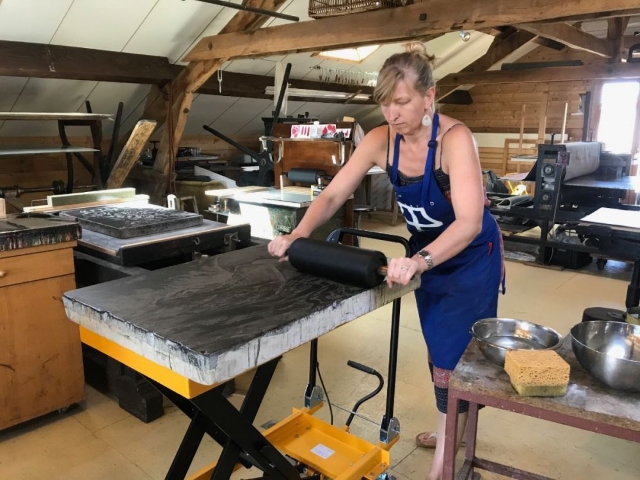
SP: Andreana, you are a well-received painter who has worked in recent years in a particular style and has recently started to experiment with lithography: who introduced you to lithography and what was the reason behind it?
AD: I have been painting for more than 20 years and had grown very comfortable with it, complacent even. I love lithography and I have always admired graphics, but whilst full of curiosity I was also slightly intimidated by it. I would not have tried it by myself: I needed someone to encourage me, and it was Emanuel who did so. Deb was my first teacher, and she was great at it! She is so sensitive and knew how to make me feel comfortable with the new medium, although it was certainly a challenge leaving my comfort zone. It was for pleasure more than anything that I tried it!
SP: Looking at your paintings, lithography seems the most appropriate printmaking technique to transfer your images onto stone for the use of the brush. Did you have previous experience with any other printmaking techniques?
AD: I have some experience with dry point. As a painter I naturally feel at home using the brush, but it is very enriching being able to try a new medium without having any preconceptions about it.
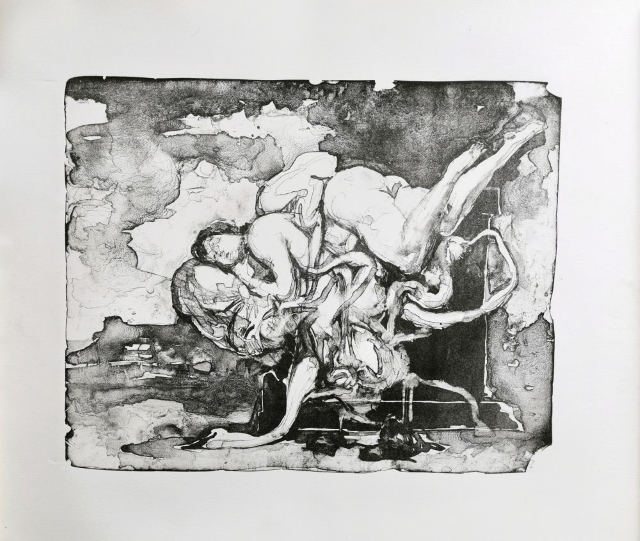
SP: To both of you, what happened after you decided to collaborate on lithography? What were the first steps?
DCG: I gave Andreana a stone to fuck up!
AD: Well first of all she taught me plenty of useful words and American expressions. She tried to teach me the way she teaches the children I think, so “this is the brush, this is the pencil” and so on. I was very impatient; I was really encouraged to fuck up the stone and I fucked it up!
DCG: When I say fuck it up, I mean in the best way possible! Try to be fearless, everyone is presented with this beautiful and pristine stone that probably took some work to prepare, so it feels like a holy object. Just use it to test out the drawing materials, see what you like and don’t like, see what you can do with the stone to make your mark, because you can work additively with the brush, litho pencil and crayon, but you can also work reductively with sand paper, etching needles, razor blades and so on. But what actually happened is you fucked up the stone with a stunningly beautiful drawing. We printed it, but I said of course you can proof it, you can change it, you can add to it or take things away.
AD: You also encouraged me to move to a bigger stone because you noticed that it was more in line with my draughtsmanship.
DCG: Yes, one thing is that if you are used to working on enormous canvases, you are used to gesturing with your arm rather than working with your fingers so much. It is finding the artist’s comfort zone that’s important.
AD: I have always had the impression that you are half teacher and half therapist.
DCG: That too! I have had many artists really open up and tell me things I wouldn’t have expected, but it also means so much that they feel so comfortable with me. It is a vulnerable space that you are allowed to enter when you work with an artist, that sacred creative zone in the mind. So those deepest darkest secrets do sometimes come into the open, but it warms my heart when someone I’m working with goes further than just “Give me that brush!”. I love what I do and part of it is really engaging personally with an artist.
AD: Deb, you told me many things which are going to stay with me for a long time! For instance, you said “Every stone is an individual and you have to listen to it”, and this helped me so much moving from canvas to stone. You simply know how to make someone feel at ease!
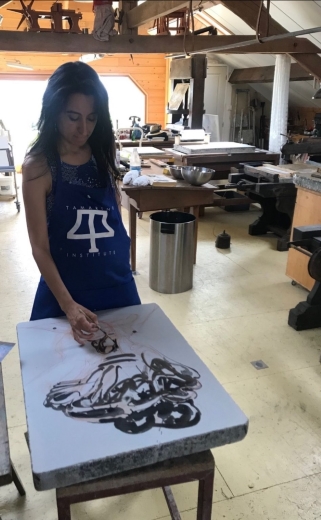
SP: Deb, that has answered the question that I meant to ask about how you support an artist experimenting with a novel technique. What about the technical side of it?
DCG: Yes, it is important to make them feel relaxed. From a technical point of view, I try not to overwhelm them with too many details; I just start with explaining how it works. That said, it is important for the artist to understand the process to a point, for instance the fact that it is very sensitive to grease, so to be careful not to touch it. So I get into the process that way, taking it back to the drawing process rather than any technical concerns.
SP: Andreana, seeing that your lithographs are so well done, one would not expect that you only just started working with this technique. It seems you’ve already mastered it after only three stones! In the process of making a lithograph, which part did you find the hardest?
AD: The hardest part was the original transition from canvas to stone, but in both cases I listen to the material, as Deb encouraged me to do. I did the same thing I do with painting: I try to let the canvas show me its own beauty, its texture. It is not just my idea and my project; it is also a conversation with the material because art is physical. Likewise with lithography, I went into the physical aspect of it. Thinking of every stone as an individual was the turning point for me. I was very rigid with my first stone, I tried to paint exactly as I would on canvas. But naturally it doesn’t work like that.
SP: How did you feel about changing from colour to black and white?
AD: A graphic is a different way of thinking. You have to reduce yourself to creating an atmosphere without the colours and temperatures, because with painting you have not only light and shadow but also temperatures, which is helpful but also challenging. I originally asked myself, ‘How can you create the same atmosphere that you require in painting?’, but quickly learnt that this was the wrong approach. I adjusted my thinking to the graphic: it is a different kind of art, and so requires a different way of thinking.
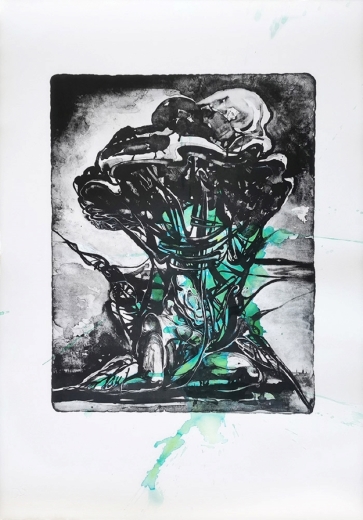
SP: Do you use lithography to create new images or do you use previous images from your own paintings? Or maybe compositions that you had already explored?
AD: I use my own compositions and images that I have already developed, but I have to adjust them considerably. I am no longer working with them in a way with which I was familiar.
SP: Deb, what is the history behind your studios in New York, Paris and La Force?
DCG: We have the Brooklyn studio, which has been mine for ten years now, and then since meeting my husband Stéphane we have had the Paris studio, where most of the work is done. Then we have La Force in the countryside, so all three offer something different. La Force lends itself to people staying and working in more of a residential setting. They can work independently if they wish, they can use the printing presses, whereas here in Paris the artist will usually come just to do the drawing. The property in LaForce was just an old farm when Stéphane bought it around eighteen years ago. We later moved an enormous press there from Paris, building the studio around it.
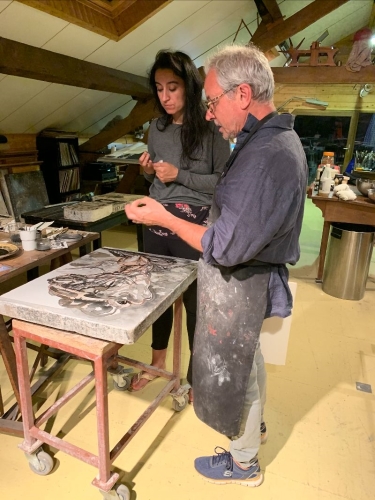
SP: Question for both of you. From the different perspectives of the artist and the printer, do you think more about the stone or more about the paper?
DCG: An image that is printed on a bright white super slick, with no texture and razor-cut edges, is going to be completely different to one printed on a thin, delicate Japanese paper. Choice of paper is of course extremely important, but developing the image comes first, and I like to compartmentalise the two phases: I focus on how to get the best image possible with the artist, and then how to best present it on paper.
SP: What about you Andreana? You have also used paper which you prepared yourself!
AD: Yes, but I only think about how to prepare the paper after the stone is finished. In the moment, the stone occupies my full attention, so I have no time to think about paper.
DCG: It’s just you and your creativity, you really are invested in each individual drawing. It is different with every artist, but with Andreana it was for sure really trying to develop and create that image that she wanted, and it worked perfectly.
SP: In terms of timing, how long does it take to make a lithograph? I imagine every artist is different.
AD: I don’t have an average measure really since I haven’t done many lithographs, but from my modest experience I would say about one day. In my opinion, the faster the better: the best is when it happens quickly and vividly.
SP: So Andreana, are we going to see more of your prints soon? What is your next printmaking challenge?
AD: My next printmaking challenge is to make more lithographs! Just doing it is a challenge in itself.